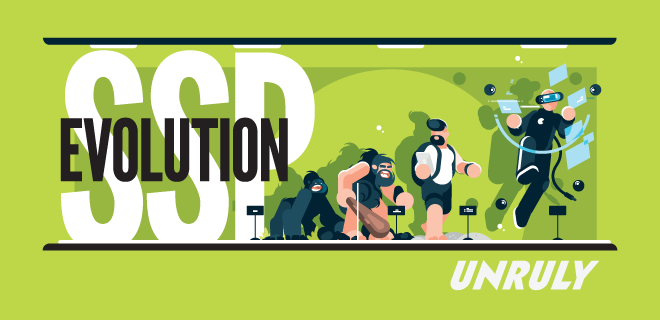
Consumers are shifting to connected TV (CTV) in droves and CTV ad spend is skyrocketing in tandem. According to eMarketer, spending is set to reach $34.49 billion by 2025.
But that doesn’t mean it’s been all smooth sailing for pubs. Besieged by a crude cast of characters — fragmentation, fraud, frequency, and let’s not forget measurement — publishers need better control of their inventory to grow monetization.
With significantly higher CPMs compared to online video, most publishers are either ready to stake their claim in CTV land or expand their footprint but in order to do so, the complexities of the industry need to be fully understood before they are addressed.
That’s when having an end-to-end solutions oriented SSP partner comes into play. We spoke with Peter Ackerman, Director of Product Marketing at Unruly to learn more about the challenges facing publishers as they expand their footprint into CTV, understanding inventory control through ad pod targeting and how ad tech can solve for these problems.
 Raquel Hudson: It’s no secret that CTV is exploding and therefore publishers are eager to tap into this space. But there is also a major learning curve for those who have lived in the world of online video, particularly around the differences in viewer behavior and the use of ad pods so let’s start from the beginning. What Is an Ad Pod?
Raquel Hudson: It’s no secret that CTV is exploding and therefore publishers are eager to tap into this space. But there is also a major learning curve for those who have lived in the world of online video, particularly around the differences in viewer behavior and the use of ad pods so let’s start from the beginning. What Is an Ad Pod?
Peter Ackerman: For some initial context, it’s important for OLV publishers to keep in mind that distributing content in CTV environments means delivering full-screen video on the largest screen in the home. So right off the bat, there is an expectation from consumers they are going to have the same high-quality viewing experience they are used to with linear TV.
Unfortunately, that isn’t always the case. Whether it’s seeing that dreaded blank screen, seeing the same ad creative repeating or multiple ads from the same brand category within a single ad break, consumers can be turned off from the experience, which is bad for the publisher, bad for the advertiser, and bad for the viewer.
Ad podding is a technology used most often to monetize longform content on CTV. An ad pod enables a sequence of ads to play together in a single ad break, just like a traditional TV commercial break, and enables pubs to generate multiple ads in sequence from a single ad request.
For ad podding to be successful it needs to meet the needs of publishers, their audiences, and buyers. For buyers, they need to provide frequency capping, creative deduplication, competitive separation, and a seamless buying experience.
For ad podding to be successful it needs to meet the needs of publishers, their audiences, and buyers.
Consumers, on the other hand, need a harmonious commercial break free of buffering and definitely no ad fatigue. And for publishers, it’s about maximizing yield for each impression, increasing the fill rate, and keeping both advertisers and their audiences happy.
Where it gets complicated for publishers is managing buying modality, those direct ad buys/insertion orders that handicap a publisher and you lose the benefits of transacting digital, and the related complexities of creating and managing ad breaks. Things like determining the duration of the break, the number of ad slots within that duration, setting the optimal price for each slot, managing for competitive separation, time between exposures, and the list goes on. That’s why you need the right ad tech and ad tech partner in place.
RH: Although CTV is seeing great success, there are still lots of questions about how to best monetize while weeding through some of its pain points (fragmentation, fraud, measurement). What are Unruly’s best practices for approaching CTV and ad pods?
PA: Lean On Industry Experts
Whether you’re just starting to dip your toes in CTV, or diving into deeper CTV waters, you want to take a tandem approach with a partner who lives in this world and has an advanced understanding of delivering a high-quality TV experience.
Discovering the right ad tech goes hand in hand with identifying the right people behind it who know the business and can help navigate uncharted waters. From issues with brand safety to the fragmented CTV landscape, as well as dealing with the robust targeting and measurement expectations that advertisers have, publishers can find themselves in murky waters unless they find a reliable partner at the onset who can help them find their way.
Diversify Ad Pod Positioning
As the CTV market grows, buyers are looking for the same kinds of targeting parameters and competitive separation they are used to in traditional TV. Ad pods provide publishers with the power to bring these requests to fruition for advertisers. For example, enabling a publisher to place a premium on certain positions like the first slot in an ad break.
Employ an End-to-End Tech Stack To Manage It All
This is where we come in. Publishers will not be able to effectively deliver this quality consumer experience if they are not working with a lead system like ours that can make ad decisioning holistically across demand channels, knowing that there is essential data passed with external connections that is key to this process.
One system decisioning makes a better decision when it comes to how the ad break is configured – and what ads should be delivered – to deliver the best quality consumer experience, while optimizing across direct-sold and programmatic demand.
Publishers also working with our SSP enables our connection to DSPs to give us better control over ad decisioning, access to unique data from our DMP to enhance the value of a publisher’s supply, and gives publishers access to the full programmatic deal capabilities of our SSP plus unique demand from our direct sales channels.
We also give publishers a single point of access to these capabilities on a self-service basis through a consolidated UI, enabling a publisher to manage, traffic, and track the revenue and performance of campaigns through a consolidated interface.
RH: There’s a lot to learn and unpack in CTV which can be a little daunting for publishers. How would you suggest they start?
PA: To start securing those higher CPMs associated with CTV, there is a lot for publishers to combat. But they shouldn’t be intimidated by the complexity of the space and understand that both buyers and sellers alike are all still figuring out the medium in real-time. It really comes down to choosing the right partner and technology solutions to solve for specific publisher needs, objectives, and KPIs. If you start from that point, you’re already setting yourself up to ride far into the land of CTV.